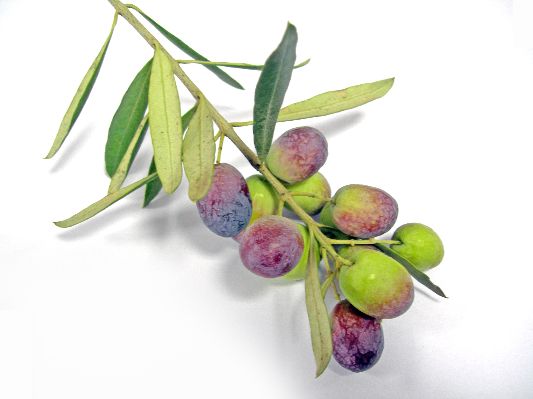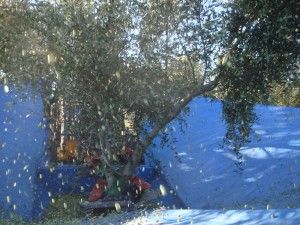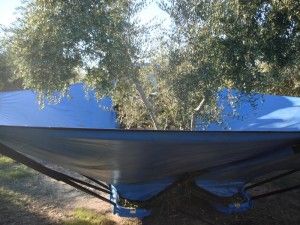Year after year the story repeats itself. As every harvest is different the same topic always comes up and gets all the olive growers talking, when to pick! It is the be all and end all. If they pick too early it will affect their yield and if they pick too late it will affect organoleptic characteristics, shelf life, and colour. So depending on the market each grower is directing his oil at, there will always be an ideal time to do the harvest. The top-of-the-range olive oils have nearly all been harvested by now. Yield is not so much of a priority here, what rules in this market are organoleptic qualities: aromas and flavours. Its a time when local neighbouring farmers sneak over the fence, so to speak to see what each one is doing. A week’s difference can have a large impact on the quality, and the better the quality the better the price. Finding the right balance between yield, colour, flavour can be tricky, even for the expert growers and tough risky decisions may have to me made if there is a poor weather forecast ahead. Although many don’t look after their harvesting techniques as much as others, olives should not be picked during or after rain and nor should they be picked up from the ground if they are destined to be extra virgin. If it is clear that the harvest is not going to be extra virgin, not so much care will be taken in protecting the fruit. The right moment depends among other things on olive variety, temperature, sunlight, and irrigation. A hot fall can cause fruit to ripen quickly, resulting in a narrow window for optimum picking. A cool fall may result in green fruit hanging on the tree well into winter. Some farmers are forced to pick greener fruit than they want to hedge against frost damage or a big storm. Some varietals will ripen faster than others, and olives may mature later in some parts of the orchard than in others. It becomes a very nervous time as the majority of Spanish olive growers do not have any insurance so a serious storm at the wrong time could put them back years just as forest fires are a major problem all through the summer.

This makes the decision on when to pick potentially complicated. Planning is still essential to make sure the picking team and equipment is ready when needed, and the mill is ready to receive the harvest and press within a max of 18-24 hours so that the olives don’t have to wait around after being harvested, running the risk of oxidation and fermentation.
Young immature olives are green and quite firm. They produce oil that can be more bitter and grassy with unique unripe and vegetative characteristics, as a generalisation but once again this depends on the variety and how well the farmer has looked after the trees throughout the year, I have tried several very young oil that were fairly sweet and not at all bitter due to the fast and controlled processing techniques. These oils tend to be higher in polyphenols (anti-oxidants) and have a more pungent flavour. As a result, they are quite bitter and have a long shelf life thanks to these natural preservatives. The chlorophyll content, generally, is also higher so the oils are often quite green, however if the milling process is fast the colour will not necessarily be that green as the chlorophyll from the skin is not passed on to the oil as much and if we talk about an Arbequina, which is a variety with a low chlorophyll content the colour will always be a more golden than green colour. It is more difficult to extract oil from unripe olives because the oil containing “vacuoles” within the cells that are not easily ruptured. The olive paste has to be blended (malaxed) for longer to break down the cells before centrifuging to separate the oil from the pulp. The yield at this stage can be anything from 12% to 18% (12 - 18 litres from every 100 kg’s of olives). However this is the part of the process that takes an enormous amount of skill and knowledge, because if you malax the paste for too long, you will loose organoleptic qualities such as aromas and you can even force unwanted elements out of the skin and into the oil. There is no second chance and it can be all over in 30 minutes. Temperature is also a prime factor at this moment; high quality mills will control the temperature at this stage and keep it at around 15ºC to preserve the qualities of the oil as much as possible. Seasonally we would be saying that these olive have been harvested during October and November.
.jpg)
As the olive fruit matures from green to yellow-green, it starts to soften and then the skin turns purple-red in colour. The olives still have a high polyphenol content at this stage, and are starting to develop some ripe-fruity characteristics. Oils produced from fruit harvested at this stage have some bitterness and some pungency and are considered balanced. They have close to a maximum amount of oil per dry weight, so they are pretty much at maximum yield, around 20-23%. The olives at this stage are often considered to be at their peak for olive oil production, seasonally this can be from the beginning of December through to the end of January, beginning of February depending on the variety and the region.
.jpg)

As the fruit matures further, the skin turns from purple to black, although some varieties never turn completely black and the flesh darkens all the way to the pit. At this stage, the polyphenol and the chlorophyll contents decline and the carotenoid content increase. Therefore, oils produced from late harvest fruit tend to be much more golden in colour, less bitter, less pungent, and have a shorter shelf life. They are often described as sweet oils. The oil yield is high at around 24-28%. However during harvest, they are soft and easily damaged meaning this can quickly reduce the quality of the oil if the fruits are bruised on the way to the mill. So, growers are often interested in harvesting as late as possible to increase oil quantity. The olive tree produces and stores oil in the fruit throughout the season, but the rate of oil storage flattens and stops just before maturity due to the low light intensity and cool temperatures, providing no real gain in oil content, so it is important not to harvest after it has totally matured. Low polyphenol content varieties such as Arbequina, if they were to have a 1-month delay in the harvest it could cause as much as a 4-month loss in shelf life due to the rapidly diminishing levels of polyphenols after maturity.
.jpg)
So once decided the time to harvest, you might be asking, “how do they do the harvest?” well there are many different technique depending on the size of your farm and your potential income. The oldest and most traditional way is to hand-harvest, the fruit is handpicked into bags or dropped into nets around the trees then collected into a crate. Additionally combs may be used to speed up the process separating more easily the olives from the tree.
.jpeg)
.jpeg)
.jpeg)
The fruit picked in this way normally shows very little damage and it is relatively free from foreign matter (soil, branches, leaves, etc.) if care is taken. This method is particularly suitable for table olives. The main limitations of this technique are the picking of the upper part of the trees and its cost of manual labour requirements. This technique is not limited to any particular tree shape. However, lower and wider canopies are best suited to hand harvesting. Hand harvest can also be complemented with long beating poles that are used to knock the olives off the tree or semi-automated machines, which are very popular among smaller groves and areas where the terrain does not allow a tractor or some other type of harvesting machine. There are two main types of hand held harvesting machines: branch shakers and combing machines. These machines greatly speed up the harvest, which is very laborious, but combing machines sometimes produce a larger proportion of damaged fruit and foreign material as they are more intrusive.

.jpeg)
Most of the harvesting machines designed for olives during the past decades were based on shaking principles or vibration. The shaker can shake the main trunk or each main branch separately; the fruit is then unattached and falls on a net or into a collecting device, which is part of the same machine. With this technique it is important to get the power right so you do not damage the tree and do not use too high a frequency of vibration as you may only want certain olive to fall from the tree, ones that have reached certain maturity. This is undoubtedly the least intrusive system for the olive fruit as it is never touched and never touches the ground, making sure it will not pick up unwanted aromas. It is a very widespread system and for high quality olive oils this system is used as it ensures that the olives receive no bruising and remain in their original state all the way to the press. However one must be very careful not to damage the tree otherwise the following harvest may suffer.


So although at first it seems daunting to get all the olives off the tree, there are techniques that have made this laborious process much quicker, but none the less it is still a lot more laborious than grape collecting and hence the cost of olive oil. One also needs to take into consideration the landmass that must be covered, approximately 6 million acres, over three times the area dedicated to vineyards in France. In Andalucía, in the region of Jaen the olive tree groves make up the largest man made forest in the world. Every year it is a colossal operation to get the olives to the press on time.
.jpeg)
Other popular articles by Ian Mackay ©
Go to article: The World of Olive Oil - Introduction-Part 1
Go to article: The World of Olive Oil- Olive Oil Categories-Part 2
Go to article: The World of Olive Oil - How to recognise an authentic extra virgin olive oil - Part 3
Go to article: The World of Olive Oil - Olive Oil Tasting - Part 4
Go to article: The World of Olive Oil - True Virginity - Part 5
Go to article: Can I fry with Oilve Oil?
Go to article: The perfect Crime Scene